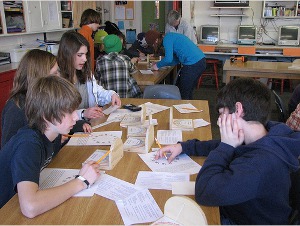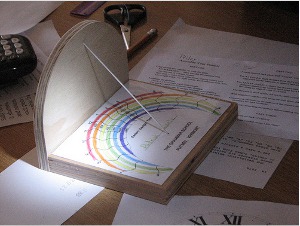 Avid dialist and former The Grammar School teacher and head of the Putney, VT school, Mac Oglesby guides 6th graders to plan and construct their own working sundials. Oglesby's students learned how to correctly position their dials to display the accurate time throughout the year.
Avid dialist and former The Grammar School teacher and head of the Putney, VT school, Mac Oglesby guides 6th graders to plan and construct their own working sundials. Oglesby's students learned how to correctly position their dials to display the accurate time throughout the year.
Oglesby has created a wide variety of sundials, all with educational value. Under his instruction, 4th graders drew dial plates this compasses and straight edges, given xerox sheets with strategically placed dots. They then glued their plates onto wood bases and assembled an upright gnomon triangle cut for their latitude. A second version used a north “wall” forming a diptych dial. Normally a string or wire extends from the dial plate to a point on this wall at the latitude angle.
As Oglesby reported, “My thinking was that if we used a wire or thin rod, it would be easily bent but impossible to straighten. And how would you keep a string taut? Elastic cord, that's the ticket. One end was formed into a “shoelace tip” by spreading super glue onto the stretched elastic, which was then trimmed when dry with a razor blade. One such tip can serve for threading many dials. Knot one end, thread through dial holes and use an alligator clip to maintain tension while forming the second knot.”
Improvements in the dial design came with each class of students. After reading an article by Gianni Ferrari and by John Singleton, Oglesby decided to use an unfolded Equation of Time curve to provide a simple sundial converts solar time into civil (clock) standard or daylight time. An entire class period was spent learning and practicing how to read this dial, since it requires knowing the date. After pointing the sundial north and sitting it on a level surface Oglesby explains how to read the time: "Find the arc for your current month and identify where it intersects the shadow line of the gnomon cord. Estimate the time where that intersection point falls between hour lines." (Half hour lines are in a light color) Use the blue hour numbers for standard time and the red for daylight savings time.
 Mac Oglesby's original sundials were made specifically for The Grammar School inin Putney, VT. Through the North American Sundial Society (NASS) his sundials are now available for any latitude between 15o N to 54o N. [The original computer program was written by Valentin Hristov (This email address is being protected from spambots. You need JavaScript enabled to view it.) who was inspired by Mac Oglesby using the NASS Delta Cad program tutorials. Robert Kellogg then modified Hristov's program further to create a series of sundials available to teachers everywhere.]
Mac Oglesby's original sundials were made specifically for The Grammar School inin Putney, VT. Through the North American Sundial Society (NASS) his sundials are now available for any latitude between 15o N to 54o N. [The original computer program was written by Valentin Hristov (This email address is being protected from spambots. You need JavaScript enabled to view it.) who was inspired by Mac Oglesby using the NASS Delta Cad program tutorials. Robert Kellogg then modified Hristov's program further to create a series of sundials available to teachers everywhere.]
The PDF file of "Spider Sundials" for each latitude is enclosed as an attachment to this article.
To make the these dials practical, they are made for the central meridian of your time zone. That is, there is no "longitude correction". Your sundial's time will differ from the central meridian, 4 minutes of time for each degree of longitude. Here are two examples:
If you live at 78o W longitude and the Eastern Time Zone meridian is 75o West, you are 3o farther west than the central meridian. When it is noon on the Eastern Time Zone meridian, you must wait for the sun to travel another 3o before you see solar noon. Since the sun travels 1o in 4 minutes of time, you must wait 4 x 3o = 12 minutes for noon. Put another way, you must subtract 12 minutes from your sundial to tell correct clock time.
If you live at 100o W longitude and the Mountain Time Zone meridian is 105o West, then your are 5o east of the central meridian. You will see solar noon before it occurs on the central meridian. Therefore, you must add 4 x 5o = 20 minutes to your sundial to tell correct clock time..
While Mac Oglesby's original dials were made using wood, the NASS “Spider Dials” are all paper. For educational use, teachers can freely copy the sundial corresponding to their latitude and make copies available to all their students. The copies should be done on thick paper. If normal weight paper is used, glue the dial onto cereal box cardboard before cutting and assembling. This gives the dial extra stiffness.
Sixth grade teacher Kathy Richardson, who remembered having Mac as a teacher herself, said, "I loved working with him. It was like old times." It was evident that her class was fully engaged in the activity of making sundials and very excited by the finished product. In conjunction with the sundial project, Oglesby introduced the students to other mathematical problems, and he notes that they were eager to tackle cube nets (geometrical puzzles), logic games, and TIZITs (optical illusion puzzles).
